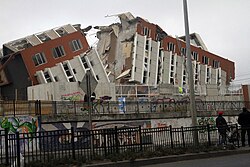
The following is a summary of significant earthquakes during the 21st century. In terms of fatalities, the 2004 Indian Ocean earthquake was the most destructive event with 227,898 confirmed fatalities, followed by the 2010 Haiti earthquake with about 160,000 fatalities, [2] the 2008 Sichuan earthquake with 87,587 fatalities, the 2005 Kashmir earthquake suffered by Pakistan with 87,351 fatalities, and the 2023 Turkey–Syria earthquakes with 62,013 fatalities.
Contents
- List of deadliest earthquakes
- List of largest earthquakes by magnitude
- List of costliest earthquakes
- Deadliest earthquakes by year
- Largest earthquakes by year
- Lists of earthquakes by decade
- Gallery
- See also
- Notes
- References
- External links
The 2011 Tōhoku earthquake and tsunami became the costliest natural disaster, resulting in approximately $360 billion in property damage at the time, followed by the 2023 Turkey–Syria earthquakes and the 2008 Sichuan earthquake, which resulted in $163.6 billion and $150 billion in damage, respectively.





















